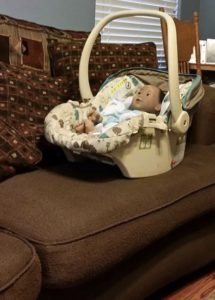Robot babies as a teen pregnancy deterrent
There’s a robot baby on the couch.
“Meet your great-granddaughter,” my daughter-in-law said, gesturing lackadaisically toward the plastic doll in the infant seat on the couch. My 15-year–old granddaughter stood nearby, grinning sheepishly. She held her arm aloft, displaying the bracelet that must be swiped across a chip in the doll’s chest to prove that its needs have been met. “Talia” cries when she’s hungry, needs to be changed, or wants comforting. My granddaughter’s mothering skills will be rated. Her high school puts its trust in this robot, touted as a deterrent to teen pregnancy.
I had my doubts from the get-go.
Doesn’t everyone already know that babies are a lot of work?
I loved my dolls when I was a girl. I even wrapped our cat’s kittens in baby blankets, and pretended my brothers were my own babies. The Besty-Wetsy doll that was my favorite still lies in a cabinet, her soft arms and legs atrophied from age. Everyone in a Catholic community prior to birth control knew that babies were work. When I got pregnant as a 16-year-old, it wasn’t because I was ignorant of the care required of a baby. I got pregnant because I was ignorant about sex. I was ignorant about standing up for myself and what I wanted or didn’t want. No one talked about sex, or desire, or birth control. Or a girl having agency in any of those things.
In the 1960s in a town of 3000 Catholics where public schools did not exist, one’s expectations for honest and open discourse about sex were non-existent. I think the bar should be higher now. A lot higher. Birth control is readily available. Tens of thousands of women my age have lost babies to adoption. Mothers these days have sought to raise our children in a more open environment. We now have decades of data and experience to inform us on the subject of teen pregnancy. Four million babies were were adopted during the Baby Scoop. The girls and young women that gave birth to those babies didn’t know what they needed to know.
Sex education is the best teen pregnancy deterrent
As it turns out, my feelings about Talia the robot and the job she’s purportedly performing have been validated by a recent study, published in the medical journal, Lancet. That research has subsequently reported just about everywhere. Newsweek, citing Lancet, reports, “Over 1,000 girls aged between 13 to 15 years old across 57 schools in Western Australia who took part in the scheme were two times more likely to get pregnant by the age of 20 than those who attended standard sex education classes, Australian scientists found.” The kicker: Teen pregnancy rates are even higher in the U.S. than in Australia.
The good news is that teen birth rates are dropping. The rate in the U.S. is at a record low. The Pew Research Center reports that the reason is “Less sex, use of more effective contraception and more information about pregnancy prevention. Furthermore, among never-married teens who have had sex, 79% of girls and 84% of boys used a contraceptive method the first time they had sex.” Holy moly is what I say to that. That never could have happened in my 1970 Catholic life. In my mind, this is the heart of the matter. Education. Contraception. Preparation. Honest talk instead of noise from a robot.



